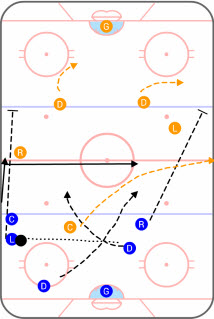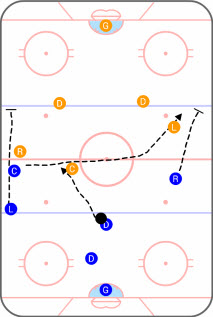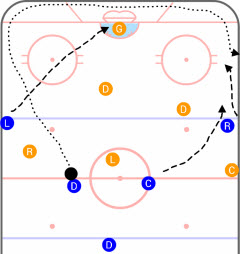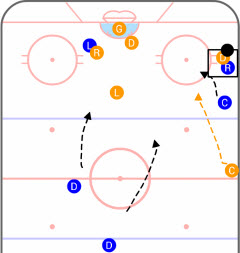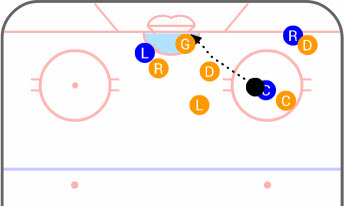Carrying the puck over the blueline in controlled possession is a clearly better alternative to deliver a shot on goal and consequently create scoring chances. Giving up possession of the puck isn’t ideal, whether by turnovers, giveaways or bad dump ins into the opposition zone. A lot of important work is currently under way to show the importance of neutral zone play and how that translates into effective zone entries and downstream scoring chances.
The zone entry data for the Flyers and Wild spearheaded by Eric Tulsky presented a soft introduction and has turned into a dynamic and unique tracking project. The results appeared in a paper submitted to the Sloan Sports Analytics Conference and only the beginning of the story - there's still a middle and end to be written.
Known as @Shutdownline over twitter, Corey has been exceptionally visible in the tracking of zone entries and exits.
The zone entry project clearly favors controlled entries (which it should), but I feel there’s an unjustified peripheral negative effect on the strategic value of a dump in play. However, there’s a difference between a dump and chase play (that puts the puck into a position that could be lost to the opposition), and a dump in that results in a play designed to get puck pressure onto the net.
A great example of this is from perennial puck possession favorites Detroit Red Wings. Sitting somewhere in the middle at the quarter mark of the ’13-14 season, Detroit is a perennial favorite to be at the top of the rankings when factoring possession analytics.
Odd for a team stressing the importance of puck retention at its core to create and use a dump in play, but here we are. Does a set play dump in focusing on setting up a scoring chance draw a parallel to giving up possession? I would posit, no.
During the third period of the Winnipeg Jets 3-2 shootout win on November 12, this play caught my eye, with all the makings of a set play through the initial movements and subsequent player positioning.
The play in its entirety is below or using this Youtube link in case the player isn't functional.
Let’s take a look at the sections and break the play down.
THE SETUP
The initial trigger is the center skating to the left side of the ice, leading the left winger up the boards and out of the zone. The left winger drops a pass to the far defenseman whose job is to get it to the red line and dump it into the zone so that it wraps around the boards hard enough to deter the goalie's ability to play it.
The important part of this beginning is to watch the center. As an added benefit, the Jets forechecking center was skating off for a line change (which begs the question is this a set play for an entire line change from the opposition, trying to catch them off guard in set up instead of ready for a staunch defense).
As the defenseman advances with the puck, both wingers skate and hold up at the opposition blueline, waiting for the puck to be sent into the zone. There’s little speed generated from the wings from a stopped position here – which initially elicited the response to focus closely on this play. As diagrammed above, the defenseman seeing the signal from the center at the red line crosses to the left side of the ice, and skates towards the far edge of the mid-ice circle.
As the defenseman moves up to the red line, the center scoots across the red line to set up for the two-man, one-sided overload and effectively pulls the defenseman and left wing in coverage.
AFTER THE PUCK IS DUMPED INTO THE ZONE
Once the puck is sent into the zone, the setup begins. The defenseman’s shot is dumped into the left side of the zone while the center sets up on the expectant strong-side as support by dropping into the lane behind the right winger. On the other side (the weak side of the ice) the left winger makes a bee-line to the net (and pulling away the right winger from the top of the zone as a result), which gives the defenseman setting up at the top of the zone plenty of room to receive a pass – should the play turn to that element, or retrieve an errant puck if there’s a breakdown in play. The play is essentially localized to the right side where we turn our attention to the specific puck battle along the boards.
THE BOXED AREA
In the boxed area, the (Jets) defenseman attempts to recover the puck on the wrap around the boards, but is immediately engaged by the right winger. This sets up the critical component of the play, since the winger’s job isn’t to really stop the puck or regain possession. His job is to take out the defenseman and force him to bobble the puck, essentially losing the battle while the trailing center picks up the loose puck.
WINGER’S RESPONSIBILITY
The winger actually does two things in this instance; he makes the play to allow the puck to get to the support trailer and also takes out the defenseman by pushing him further down into the zone and impeding the ability to get back into position in a timely fashion.
The result is an open lane, giving the center with the loose puck a clear path to the goal (with options on the weak side of the ice). The Jets other defenseman who stopped in front of the net as a crease presence, and the left winger converged into the area to stop the play, but they’re not quick enough to stop the shot on goal.
The alternative in this play is if the winger doesn’t win the puck battle along the boards and the puck is nestled between them in a scrum, the center provides manpower support and the opportunity to take the puck with the winger physically making the sacrifice to tie up the defenseman. There is an added effect to this by playing the puck to the open defenseman on the weak (left) side due to the lack of high zone presence – or he can send it around the boards back to that defenseman and forcing the opposition to scramble back into position, which subsequently opens up other lanes and opportunities for a goal mouth scramble.
In this instance, the winger did his job and took out the defenseman effectively creating the opening for the eventual shot on goal.
The play in general however has the makings of generating a quick shot, while offering expanded opportunities to make another play with controlled possession in the opposition zone, all created through a set-play dump in.
**********
Follow the McKeen's team on Twitter:
































